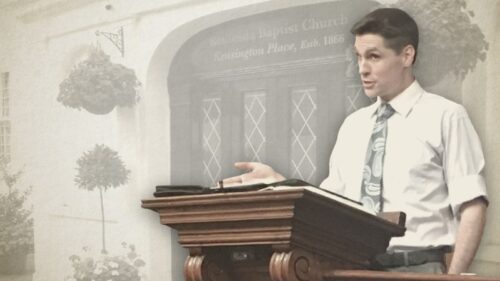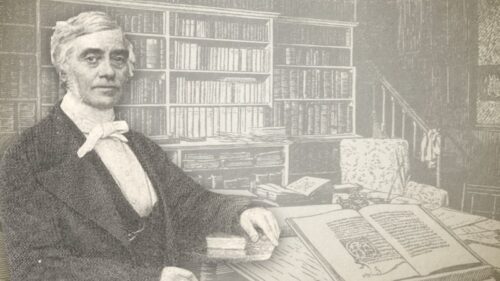-
Offers Of Christ And Proffers Of Grace
O marvel, that among other devices of Satan to distress sinners, and cause them to despair of God’s mercies in Christ Jesus, he urges this also: ‘Your day of grace is past, the time of your visitation is ended.’ Hence many poor souls have been driven to their wits end. And have not some preachers been so too, who have increased such persons fears by speaking in a most unscriptural manner on this point? Such are the effects of human systems, and free-will notions, with their offers of Christ, and their proffers of grace. I heard one declare, ‘This is the last offer; if it is not now accepted, eternal damnation will be the inevitable consequence.’ Does thus preaching of hell and damnation make converts…
-
38 Bible Doctrine – Confessional Statements And Their Proper Use
I would like to welcome you back to another study in Bible Doctrine. In our previous two studies, I have given a historic and doctrinal overview of John Gill’s Goat Yard Declaration of Faith. And then, towards the end of our last study, I pointed out some of the major differences between the 1689 Confession and the 1729 Declaration. In a nutshell, the 1689 Confession is representative of 17th century Hyper-Calvinism, whereas the 1729 Declaration is representative of 18th century Hyper-Calvinism. More specifically, 17th century Hyper-Calvinism, represented by the 1689 Confession, is based on a threefold covenantal framework, pushing to the forefront a conditional covenant of grace. Forthwith, saving faith is viewed as a legal duty imposed upon unregenerate sinners, resulting in a conditional salvation;…
-
The Origins Of The Particular And The Reformed Baptists
This question was recently put to me by a friend: ”Jared are you on the same side with Sam Renihan and his father on the issue of origins of Particular Baptists and Reformed Baptists?” My answer (with a few additions for the sake of clarity): No, we certainly would not be in agreement with the Reformed Baptists’ view on these matters. The reformed Baptist movement began in England during the 1950’s, taking over historic Particular Baptist churches and ‘unreforming’ them to align with their teachings. The group of Particular Baptist churches they commandeered belonged to the Metropolitan Association of Strict Baptist Churches (London). The church that I pastored for twenty years was
-
9 The Earthly And Temporary Covenants: The Error Of A Conditional Covenant Of Grace With Its Duty-Faith And Free-Offer Perversions
I’d like to welcome you back for another study in the Word of God. We come again to the subject of the earthly and temporary covenants. And if you remember, I believe these covenants can be arranged under one of two categories. First, there are two spiritual and perpetual covenants—this would be that of Redemption and that of Works. And then secondly, there are four earthly and temporary covenants—that which God made with Noah, with Abraham, with Moses and with David. As for the New Covenant, I don't believe this is an actual covenant, but rather, it's an explanation for the Covenant of Redemption to the Jewish people as a nation as they were then under the Mosaic economy and subject to its laws.
-
37 An Examination Of Gill’s Goat Yard Declaration Of Faith (1729)
I would like to welcome you back to another study in Bible Doctrine. In our previous study, I laid out for you a historic backdrop to Gill’s Goat Yard Declaration. For this study, I would like to look at the document itself. However, it seems appropriate, given the fact that the Declaration was designed for a single congregation, that we first take a look at that congregation, to gain a bird’s eye view of its history and doctrinal positions. The Goat Yard Declaration was named after the church for which it was drawn up. It was known as the church meeting at Goat’s Yard Passage, on Fair Street, in Horsley-Down, Southwark, and they met in the Goat’s Yard Chapel. The origin of the church may…
-
36 A Historical Backdrop To Gill’s Goat Yard Declaration Of Faith (1729)
I would like to welcome you back to another study in Bible Doctrine. In our previous study, I introduced you to the ministry and writings of an 18th century Baptist theologian named John Gill. Aside from his pastoral duties in London, he was a prolific writer, the author of more than twenty-five works, many of which were large and exhaustive volumes. Of these works, there are four which I recommended you should have and of which you should make frequent use: 1. “The Cause of God and Truth” (1735-38) 2. “An Exposition of the Old and New Testaments” (1746-48; 1763-66) 3. “Goat Yard Declaration of Faith” (1729) 4. “A Body of Doctrinal and Practical Divinity” (1769-70) Having already given an overview and samples of the…






